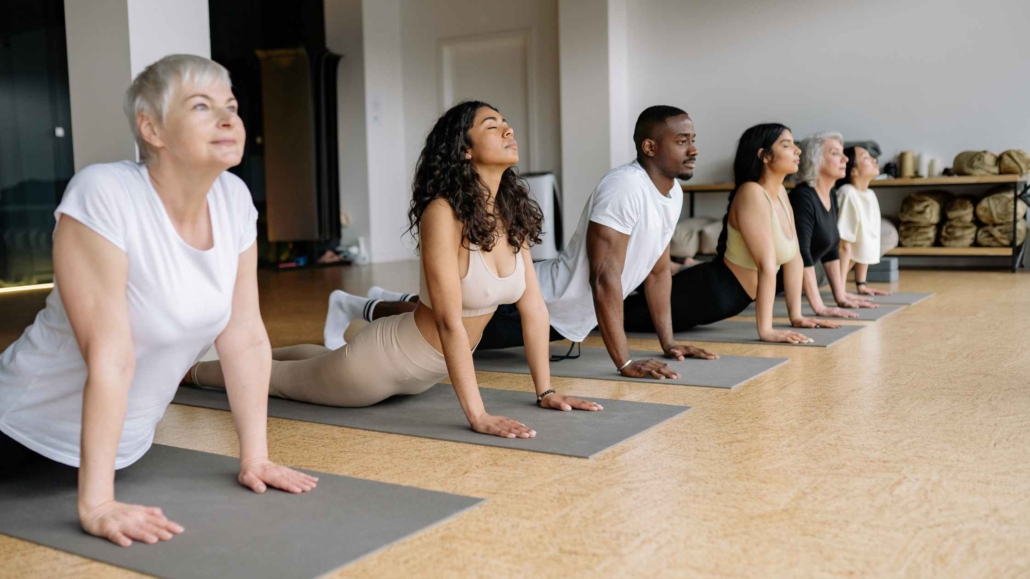Last Updated on January 9, 2025 by
Temperature requirements for group exercise spaces aren’t one-size-fits-all.
While general gym areas operate at 16-18°C, group exercise classes need specific conditions – from high-intensity sessions at 18-20°C to yoga studios requiring 26°C.
Getting these temperatures right isn’t just about comfort; it’s essential for class safety and effectiveness.
Let’s explore exactly what temperature works best for different class types, and what to do when spaces aren’t quite warm enough.
Download our free group exercise risk assessment templates to ensure your classes meet all safety requirements.
Key Takeaways
- Base temperature for group exercise spaces should be 18°C, with specific requirements for different class types
- High-intensity classes need 18-20°C with 50% humidity for optimal conditions
- Temperatures between 26-32°C can cause fatigue during prolonged exercise
- Temperatures above 32°C present serious risks of heat exhaustion and heatstroke
- Regular temperature monitoring and clear protocols are essential for maintaining professional standards
Temperature Requirements in Studios Explained
Every class type has its own ideal temperature range. For those high-energy, heart-pumping sessions, you’ll want the room sitting between 18-20°C with 50% humidity.
Keeping the space comfortable enough for intense movement without risking overheating is key.
Mind-body classes each have their own sweet spot too – Pilates works beautifully at 18°C, while yoga needs a warmer 26°C to help muscles stay supple and responsive.
Hot Yoga naturally needs things much toastier, with temperatures reaching 32.2°C and 40% humidity for that perfect environment.
Temperature control becomes particularly important in spaces used for multiple class types throughout the day.
A morning Pilates class might need different conditions from an afternoon HIIT session, and pool areas need special consideration, maintaining temperatures between 21-26°C to balance comfort and safety.
When Cold Becomes a Concern
You’ll spot the signs before anyone says a word. Participants keeping their jackets on, movements looking a bit stiffer than usual, that distinctive damp feeling in the air – they’re all clear indicators that your space isn’t quite warm enough.
Cold temperatures do more than just make people uncomfortable. They significantly impact class quality and safety, making muscles slower to warm up and more resistant to movement.
When it’s too cold, even experienced participants might struggle with their usual form, especially during complex movements or when working with resistance.
Managing Temperature Challenges
When your space isn’t quite hitting the right temperature, there are several ways to adapt. A longer warm-up might be needed, or you might want to keep movement flowing more continuously throughout class.
Keep an eye on how everyone’s moving – cold muscles need extra attention to maintain good form.
Consider modifying your usual class structure. For example, you might incorporate more dynamic movements early on, reduce static holds, or adjust the intensity to maintain appropriate body temperature.
Professional Considerations
Temperature management isn’t just about the immediate class environment – it’s about maintaining professional standards and participant safety.
Regular temperature monitoring helps track patterns and identify potential issues before they become problems.
Document any concerns and keep those communication channels with facility management open.
Key monitoring points include:
- Where possible, check temperature on arrival at the venue
- Participant feedback and comfort levels
- Equipment condition and usability
- Ventilation effectiveness
The Indoor-Outdoor Balance
Moving your classes outdoors? That’s a whole different game. While indoor studios give you control, outdoor sessions need extra planning and a solid weather eye.
Create some clear guidelines about when it’s good to go and when it’s time to call it – think minimum temperatures and wind chill factors that actually make sense for your class type.
Success outdoors isn’t just about instructor prep – your participants need to know what they’re doing too.
Guide them on smart layering choices: moisture-wicking base layers, insulating mid-layers, and outer layers that’ll keep the wind at bay.
And don’t forget about appropriate footwear – nobody performs well with frozen toes!
Making Informed Decisions
Sometimes you need to make quick calls about temperature issues. Having clear protocols helps, but use your judgment too.
Think about who’s in your class, what type of session you’re running, and what alternatives you’ve got up your sleeve.
Need to modify? Focus on keeping quality high while adapting to conditions. Maybe that means changing up your class plan or adding more recovery periods.
Just remember to keep your participants in the loop – they’ll appreciate knowing what’s happening and why.
The Bottom Line
Getting your studio temperature right isn’t about being fussy – it’s about creating the best possible environment for your participants.
While different classes need different conditions, the goal stays the same: safe, effective, enjoyable sessions.
Stay alert to changing conditions, trust your instincts, and don’t shy away from speaking up about temperature issues.
After all, maintaining the right environment isn’t just part of the job – it makes great instructors stand out from good ones.



